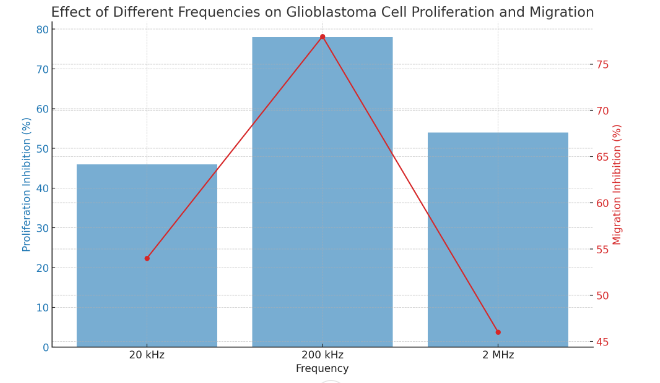Harnessing Electromagnetic Fields in Cancer Therapy: A Novel Approach
Glioblastoma (GBM), the most aggressive form of brain cancer, presents a formidable challenge in oncology. Characterized by rapid growth and a high recurrence rate, GBM’s prognosis remains grim. Traditional treatments—surgery, chemotherapy, and radiation—offer limited relief, often accompanied by severe side effects and complications.
“Cell experiments confirmed that the reduction in proliferation and migration of glioma cell by TTFields was in a frequency- and field-strength-dependent manner.” TTFs: Low-strength intermediate-frequency (IF) alternating current (AC) electric fields.
The world of cancer treatment is witnessing a remarkable shift with the advent of Tumor-Treating Fields (TTFields) technology. This approach has significantly altered the management of glioblastoma (GBM), a particularly aggressive brain tumor. TTFields use low-strength, intermediate-frequency alternating current (AC) electric fields, offering a non-invasive, localized treatment without the systemic toxicity often associated with conventional cancer therapies.
Glioblastoma behavior study under different frequency electromagnetic field

The chart illustrates the effects of different frequencies on glioblastoma cell proliferation and migration. The blue bars represent the percentage decrease in cell proliferation, while the red line indicates the percentage decrease in cell migration across three frequencies: 20 kHz, 200 kHz, and 2 MHz.
Key observations:
- At 200 kHz, there’s a significant decrease in both cell proliferation (78%) and cell migration (78%).
- At 20 kHz and 2 MHz, the effects on cell proliferation and migration are less pronounced compared to 200 kHz.
- The frequency of 200 kHz appears to be the most effective in inhibiting both cell proliferation and migration
Traditionally, it was believed that the effects of RFR on biological tissues were predominantly thermal and directly proportional to the power or intensity of the radiation — essentially, more power meant more damage due to heating effects. However, emerging research, particularly in the field of Tumor-Treating Fields (TTFields) and similar technologies, challenges this view by demonstrating that biological effects of RFR can be frequency-specific and do not always correlate linearly with power.
Nonlinear Response to Frequencies
- Frequency-Specific Effects: Studies have shown that certain frequencies of RFR can produce significant biological effects at power levels much lower than those necessary for thermal damage. For example, in TTFields therapy used for treating glioblastoma, specific low-intensity frequencies in the range of 100-300 kHz are employed to disrupt cancer cell division. This effect is not achieved by heating but through a frequency-specific interaction with cellular processes.
- “Windows” of Effectiveness: This phenomenon is sometimes referred to as “windows” of effectiveness, where certain frequencies are particularly effective at producing a biological response. These windows do not necessarily align with higher power levels and instead are more related to how specific frequencies interact with biological structures and processes.
Supporting Research
- TTFields and Cancer Treatment: Research on TTFields has been crucial in understanding these nonlinear responses. Studies have demonstrated that specific frequencies can disrupt the mitotic process of cancer cells, leading to reduced proliferation and migration. This occurs without significant thermal effects, indicating a non-thermal, frequency-dependent mechanism.
- Ion Cyclotron Resonance Theory: The theory of ion cyclotron resonance (ICR) in biological systems suggests that electromagnetic fields at certain frequencies can resonate with ions moving in a magnetic field. This resonance can affect ion transport and other cellular processes in a way that is highly dependent on frequency, rather than power or intensity.
- Cellular Signaling and Electromagnetic Fields: Research has also shown that low-level electromagnetic fields can affect cellular signaling pathways. These effects are often nonlinear and depend more on the pattern and frequency of the fields than their intensity.
Understanding TTFields’ Mechanism While TTFields have shown promise, understanding their biophysical principles remains crucial for further improvement. This study delves into the effects of varying electromagnetic frequencies and field strengths on cells, particularly during the cell division phase known as mitosis. By employing sophisticated simulations, researchers were able to predict a local increase in the cleavage furrow region of dividing cells, which is believed to contribute to TTFields’ anti-proliferative effects.
Impact on Cell Division and Migration One of the key findings of this study is the frequency and field-strength dependence of TTFields’ effects on mitotic cells. These fields can interact with proteins like tubulin dimers, potentially disrupting the mitotic spindle’s integrity and impeding cell division. Moreover, the study highlighted TTFields’ ability to inhibit cell migration, a critical factor in the aggressiveness of GBM.
A Deeper Dive into Frequency and Field Strength To optimize TTFields’ application, it’s crucial to understand how different frequencies affect cells. The study revealed that as the frequency increases, so does the uniformity and intensity of the electric field within the cell. Specifically, intermediate frequencies (around 200 kHz) were found to enhance the electric field strength in the cleavage furrow region, a key area for cell division. This increase in field strength was observed to be substantial during the telophase stage of mitosis, suggesting a more potent impact on intracellular proteins and thus inhibiting the mitotic process.
Dissecting TTFields’ Efficacy The study’s simulations indicate that TTFields predominantly affect the cellular cytosol, initially penetrating the cell membrane and intensifying the electric strength experienced by the cytoplasm. As the frequency rises, the electric field also affects the nuclear envelope, impacting crucial cellular functions like DNA repair. This nuanced understanding of TTFields’ mechanism implies a direct influence on cellular division, primarily affecting the cytosol and subsequently the cell nucleus at higher frequencies.
Overview of the Optune System
In this landscape, the Optune system emerges as a beacon of innovation. This FDA-approved therapy represents a paradigm shift in GBM treatment, offering a new lease on life for patients battling this relentless disease.
How Optune Works
At the heart of the Optune system is the groundbreaking Tumor-Treating Fields (TTFields) technology. It employs low-intensity, alternating electric fields to target cancer cells. These fields disrupt cell division, effectively halting tumor growth without the invasiveness of conventional therapies.
Benefits of Optune
Optune’s non-invasive nature stands in stark contrast to the physically taxing treatments typically associated with cancer. Its targeted approach minimizes collateral damage to healthy cells, significantly reducing adverse side effects. This precision marks a significant advancement in cancer care, aligning treatment with the ethos of patient-centric medicine.
Clinical Evidence and Success Stories
Clinical trials and patient stories underscore Optune’s effectiveness. Key studies have shown a notable improvement in survival rates for GBM patients. Personal narratives of those who’ve undergone the treatment echo these findings, offering hope in the face of a previously relentless adversary.
Optune’s Quiet Revolution: Redefining RF Radiation’s Role in Medicine and Beyond
In the bustling world of high-frequency devices like cell phones and smart gadgets, a quiet revolution is underway in the medical field, led by the Optune system. This pioneering technology in the fight against glioblastoma (GBM) is turning the tables on long-held beliefs about radiofrequency (RF) radiation. By using frequencies far lower than those emitted by everyday wireless devices, Optune challenges the notion that the sole impact of non-ionizing RF waves is heating, opening our eyes to their untapped therapeutic potential and raising questions about their broader effects.
Challenging the Heat-Only Paradigm
- A New Understanding of RF Radiation: For years, the scientific community believed that non-ionizing RF radiation, like that from cell phones, only posed a risk in terms of heating biological tissues. Optune, operating in the lower frequency range of 100-300 kHz, starkly contrasts with the GHz frequencies of cell phones, demonstrating that RF radiation can have profound biological effects beyond mere thermal ones.
- Revisiting Cellular Interactions: Optune’s efficacy in disrupting cancer cells without significant heat generation suggests that RF radiation can interact with cellular processes in more ways than previously understood. This revelation invites a reexamination of how everyday exposure to RF radiation from wireless devices might affect healthy cells.
The Power of Lower Frequencies in Cancer Treatment
- Targeted Cellular Disruption: Optune uses its lower frequencies to specifically disrupt the mitotic process in cancer cells, effectively halting their proliferation. This targeted approach leverages the non-thermal properties of RF radiation, exploiting the vulnerabilities of cancer cells without damaging surrounding healthy tissue.
- Implications for Non-Cancerous Cells: The success of Optune raises questions about the broader implications of RF radiation. If specific frequencies can disrupt cancerous cells, there’s a possibility that other frequencies, perhaps those used by cell phones and smart devices, could unintentionally influence healthy cellular processes.
Beyond GBM: A New Frontier in Oncology
- Expanding the Scope: The principles behind Optune’s low-frequency treatment have potential applications beyond GBM. This approach could be tailored to other cancer types, harnessing the unique interactions of RF radiation with different cellular structures.
- A Call for Comprehensive Research: Optune’s success underscores the need for more comprehensive research into the effects of RF radiation across the spectrum. Understanding these interactions is crucial, not just for advancing cancer treatment but also for evaluating the long-term health implications of pervasive wireless technology.
Navigating the Future
- Balancing Benefits and Risks: As we embrace technologies like Optune in medicine, we must also be vigilant about understanding the broader effects of RF radiation. This calls for a balanced approach that harnesses the benefits while mitigating potential risks.
- Innovating Responsibly: The journey of Optune represents a broader theme in technological advancement – the need for continuous reevaluation and responsible innovation. As our capabilities grow, so does our responsibility to understand and mitigate the unintended consequences of our inventions.
In conclusion, Optune’s approach to treating GBM with low-frequency RF radiation not only offers new hope in the fight against cancer but also challenges us to rethink our relationship with technology. It serves as a reminder that in our quest for progress, we must remain open to new possibilities, constantly reassessing our assumptions and striving for a deeper understanding of the world around us.








